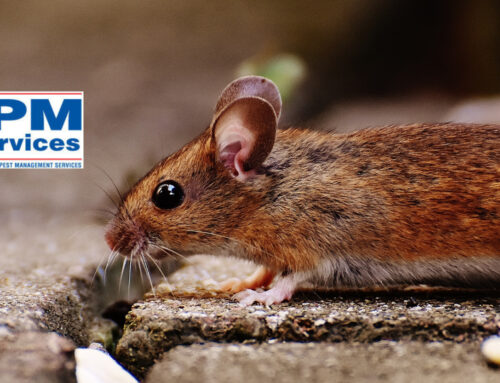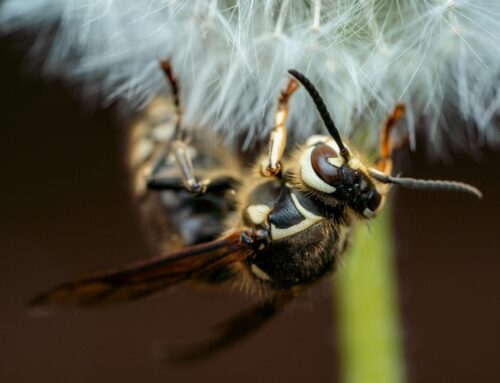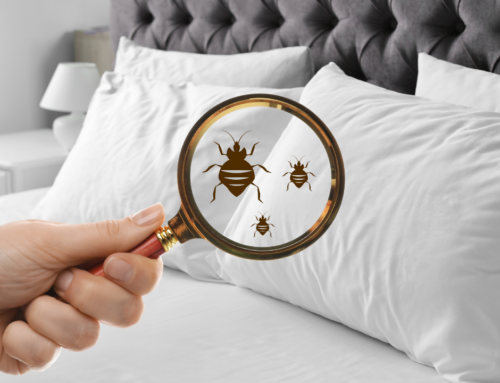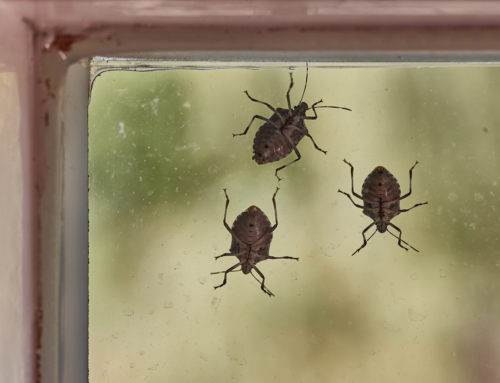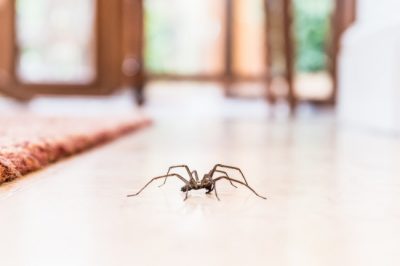
Spiders don’t really like you either. They are often “accidental invaders” because they don’t purposely invade your home to scare you. They are just looking for the ideal place to hunt, live, and breed. Spiders are everywhere. You can find them in your bedroom closet or in Churchill Downs, and most of them are beneficial. Only a few species are actually toxic or harmful to humans, but that doesn’t mean we want to invite the spiders in Kentucky to the dinner table.
How To Identify Spiders
When you see a creepy crawly scurrying across the floor or hiding in the corner of your room, many will automatically assume that it is a spider. But there is a chance it could be another insect. There are some specific features to look for to know for sure if you have a spider on your hands.
- Size: most of the common house spiders range from 5mm to 8mm.
- Color: Common house spiders are usually brown or gray in color, with some darker markings along their bodies
- Features: Common house spiders’ bodies are divided into 2 parts; cephalothorax and the abdomen. And if you can get close enough to see, spiders have eight eyes.
If you would really like to identify the types of spider you’re dealing with, try getting a picture of it and comparing it to the list of common house spiders in Kentucky below.
Where Do Spiders Like to Hide
Your common house spiders in Kentucky are simply called a “house spider” because they like to live in human dwellings. The most common places you will find spiders are:
- Inside your vegetation: Spiders love the shade, cover, and insects in a garden. If you have bushes, shrubs, or plants, there are probably spiders nearby. To keep them at bay, keep your shrubs and bushes well trimmed and cared for.
- Under furniture: Because it’s dark, quiet, and cool, spiders love to hang out under furniture. The best way to deter them is to keep this area clean and vacuumed regularly.
- Within your clutter: Spiders love a good hiding spot and clutter gives them ample options. Piles of books, papers, and toys that are never played with are perfect for spiders.
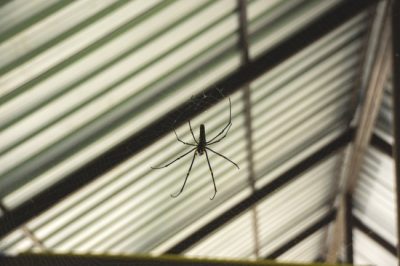
- In closets: Closets are dark most of the time, making them perfect for spiders. When it’s time to clean out that closet, check for eight-legged hitchhikers.
- Within cracks in the wall: While some types of spiders in Kentucky want space to web, others prefer tiny cracks and crevices. Wolf spiders specifically prefer these areas so it’s important to seal all openings and holes.
- In the corners near your ceiling: The ceiling is the most popular place to find a spider. Why? Because they can hang out in the ceiling and find prey easier. If you don’t do a thorough spider removal, they’ll lay eggs and your problem just got a whole lot bigger. Vacuum their webs out regularly to keep them at bay.
- Under rocks and woodpiles: Rocks and wood piles are prime real estate, but if these piles are near your home, they can make their way inside. Specifically, more dangerous species of spiders tend to hide in these areas.
- In the garage: The garage is a likely spot to find spiders in Kentucky who are looking for somewhere to stay warm. Check it regularly, seal entry points, cracks, holes and if you notice more than one or two, it’s time to call a professional to take care of the problem for you.
How to Prevent Spiders From Coming Into Your Home
Spiders in Kentucky can be beneficial in a garden, but we certainly don’t need them in the home. The best way to prevent spiders from getting into the home is by making it harder for them to survive. Encourage them to stay outside where they belong by making your home a little less inviting.
- Keep grass mowed so that your yard doesn’t become an overwhelming breeding ground.
- Trim shrubs, especially those around your house so that spiders don’t accidentally find themselves inside.
- Vacuum frequently, especially in dark corners, underneath furniture and in closets.
- Dust and remove existing spider webs. Sometimes spiders will find where past spiders have caught food and build their own web.
List Of Poisonous Spiders Found in Kentucky
People are understandably scared of poisonous spiders. Being bitten can cause severe pain, reactions, and sometimes even death if not properly treated. A little spider identification and education can reduce your chances of an unwanted encounter. According to the Kentucky Department of Fish and Wildlife Resources, there are two poisonous spiders in Kentucky you need to be on the lookout for.
#1 – The Black Widow Spider
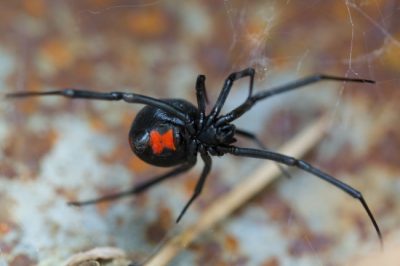
Black Widows are found all over Kentucky but are not naturally violent. They will bite if you disturb them or their home. A bite from a Black Widow needs to be treated immediately by a medical professional. As soon as you are bitten, draw a circle around the bite mark and head straight to the emergency room. The circle will allow the doctor to see how the bite is progressing over time.
- Color: Females are a glossy black with red markings on the top and bottom of their abdomen and males have additional white markings.
- Size: ½”
- Shape: Abdomen is almost spherical on adult females and males are slimmer with longer legs.
- Hiding Spots: Piles of rocks, firewood, and dark corners of garages and sheds.
#2 – The Brown Recluse
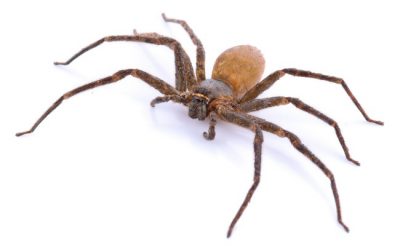
A bite from a Brown Recluse is very serious and requires immediate medical attention. While they are found in Louisville, KY and throughout the state, they are timid and unlikely to bite unless handled or disturbed.
- Color: Tan to dark brown, abdomen and legs are uniformly colored.
- Size: about the size of a quarter with its legs stretched out
- Shape: Long skinning legs with a dark colored violin-shaped mark on the cephalothorax, or top of its body. Only has 6 eyes instead of 8.
- Hiding Spots: They tend to live in hidden locations indoors and outdoors, like piles of cardboard or paper, stacks of cut wood, and wall-voids of buildings.
List of Non-Poisonous Spiders Found in Kentucky
We share this great state of Kentucky with several spider species. These types of spiders in Kentucky are not harmful to humans. While they can bite, they do not carry venom or poison. They may be creepy and crawly, but they are not going to pose a health-risk unless you have an allergy. Common non-poisonous spider identification basics include:
#1 – Wolf Spider
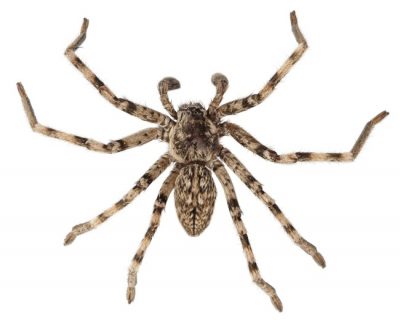
- Color: Light or dark brown with contrasting spots or stripes.
- Size: Range from the size of a pencil eraser to about the size of a U.S. silver dollar with its legs stretched out.
- Shape: V-shaped back with thin legs and long spines on the “foot”.
- Hiding Spots: They like grassy or leaf-covered areas.
- Additional Info: They are fast moving, and typically seen running which makes them seem aggressive, they can bite but do not like to stay indoors and are usually trying to find a way outside.
#2 – Funnel Web Spiders (Agelendiae)
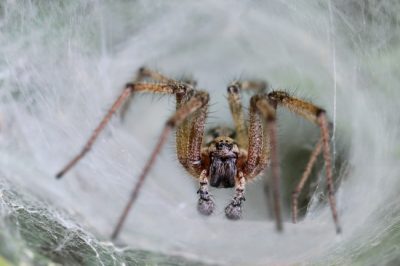
- Color: Dark brown or tan coloring, similar to a wolf spider.
- Size: Long and oval body with long, slender, and bristly legs.
- Shape: They have two long silk spinning tubes at the rear of the abdomen.
- Hiding Spots: Shrubs, grass, under rocks, and in debris is where the funnel web spiders like to stay.
- Additional Info: They are well known for their sheet-like webs in a funnel shape. They are obvious when you see them because of their distinct shape.
#3 – Fishing Spiders (Pisauridae)
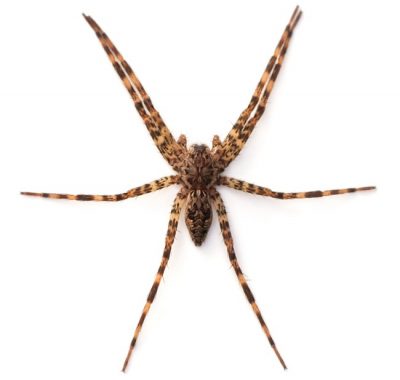
- Color: Brown, sometimes with contrasting patterns.
- Size: A little larger than a U.S. silver dollar with its legs stretched out
- Shape: Usually distinguished by their size and positions of their eyes, which are in two rows of four.
- Hiding Spots: Usually near streams, wooded areas, or on tree trunks. They sometimes wander into homes but prefer damp spaces, like basements.
- Additional Info: Although they are one of the biggest spiders in Kentucky, they are harmless (except for those who are allergic).
#4 – Jumping Spiders (Salticidae)
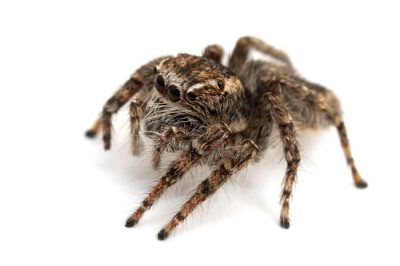
- Color: Gray or black, some others are brightly colored.
- Size: Typically about the size of a U.S. dime.
- Shape: Small body with a flat face
- Hiding Spots: They are common homes and buildings because they wander, or jump inside unexpectedly from porches, garages, and windows.
- Additional Info: They are known for herky-jerky motions and do not build webs. They have a flat face look, but are harmless to humans.
#5 – Crab Spiders (Thomisidae)
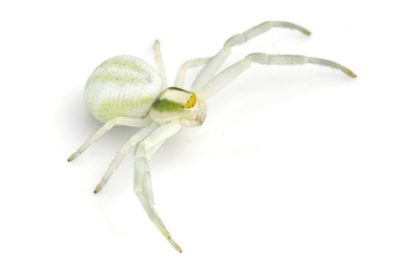
- Color: They can be brown or tan, but often are bright white or vivid neon green.
- Size: About the size of a nickel with its legs stretched out
- Shape: They have to long front legs, which makes them look a bit like a crab shape.
- Hiding Spots: They love Kentucky flowers where they can find hearty bees to hunt.
- Additional Info: If they are in a home, they wandered in unexpectedly. If they are brown in color, they’re often mistaken for a brown recluse.
#6 – Yellow Sac Spiders (Clubionidae)
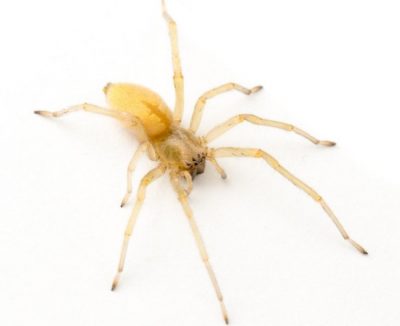
- Color: Tan legs with a yellow abdomen.
- Size: About the size of a nickel with its legs stretched out
- Shape: Similar to a brown recluse, but the yellow sac is a clear difference. Only has 6 eyes instead of 8.
- Hiding Spots: They like to stay on foliage or in the ground. They’ll often build a cylindrical retreat in rolled up leaves or folds of grasses.
- Additional Info: The bite of a yellow sac can be painful, but is not medically significant.
#7 – Cellar Spiders
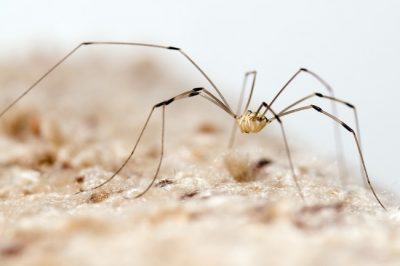
- Nickname: Sometimes referred to as “daddy-long-legs” or “granddaddy-long-legs”
- Color: Light tan or gray with darker markings
- Size: About the size of a U.S. half dollar with its legs stretched out
- Shape: Very long and thin legs.
- Hiding Spots: They are the most common spiders found in homes in Kentucky.
- Additional Info: They are sometimes mistaken for brown recluses, but often hang upside down under their webs.
#8 – Orb Weavers (Araneidae)
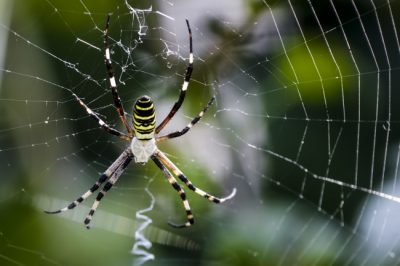
- Color: Tan to dark brown, some have colorful patterns.
- Size: Range from the size of a pencil eraser to about the size of a U.S. silver dollar with its legs stretched out.
- Shape: Long skinning legs with a dark colored violin-shaped mark on the cephalothorax, or top of its body. Only has 6 eyes instead of 8.
- Hiding Spots: They like porches and gardens in Kentucky, sometimes they’ll build a web in a doorway or windowsill.
- Additional Info: They are expert web builders. No other common spiders makes more organized and grid-like webs as the orb weavers do. They are almost always found inside their webs.
#9 – Purse Web Spider
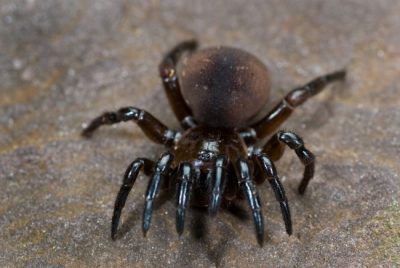
- Color: Glossy black, sometimes with white markings.
- Size: Larger spider, about the size of a U.S. half dollar with legs outstretched.
- Shape: A large spider with very low, flat bodies. Larger than a black widow, but often mistaken for one because of their glossy black color.
- Hiding Spots: They are commonly found in the forest that are in Kentucky. They keep their tube-shape webs hidden so they are pretty rare to actually see, especially in homes.
- Additional Info: Well known for their ambush hunting abilities, a close relative of the tarantula.
We Are Your Spider Experts
Knowing where certain spiders in Kentucky like to hide and how to identify them is your first step in preventing spiders from coming into your home. If you find spiders in your home, give IPM a call. We will do a thorough evaluation of the situation and provide the best extermination solution. To control your pests, call the best!


